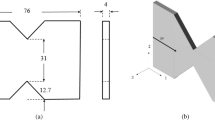Abstract
Pultrusion is a process allowing the production of unidirectional (roving) fibre-reinforced polymer (FRP) structural elements with constant cross section. Recently, also civil engineers focused their attention on pultruded composite materials as alternative to traditional ones (e.g., concrete, steel). Furthermore, to improve the transverse strength and stiffness with respect to the fibres direction, continuous filament mat (CFM) is often placed within the stacking sequence. The CFM influence on the global mechanical behaviour is not considered by appropriate actual international standards. In this paper, the influence of the CFM layers on the mechanical behaviour of glass fibres pultruded composite material is investigated. In particular, the bending behaviour is analyzed by performing a four-point bending test on specimens extracted from an H-shape member. The experimental analysis was carried out via Electronic Speckle-Pattern Interferometry (ESPI) (handled by phase-stepping technique) to obtain a full-field displacement map and to numerically achieve the longitudinal strains. By imposing the equilibrium conditions and assuming the compression and tensile roving Young’s moduli as constant, the CFM Young’s moduli are determined. Finally, the mean stress acting on the material is obtained showing that CFM layers have to be considered to correctly evaluate the maximum stress and to optimize the design phase.
Similar content being viewed by others
References
R.M. Haj-Ali, A.H. Muliana, A micromechanical constitutive framework for the nonlinear viscoelastic behavior of pultruded composite materials, International Journal of Solids Structures 40 (2003) 1037–1057.
L. Calabrese, A. Valenza, The effect of a liquid CTBN rubber modifier on the thermo-kinetic parameters of an epoxy resin during a pultrusion process, Composite Science Technologies 63 (6) (2003) 851–860.
R. Haj-Ali, H. Kilic, Nonlinear behaviour of pultruded FRP composites, Composites Part B: Engineering 33 (3) (2012) 173–191.
C.A. Scimmarella, L. Lamberti, Basic models supporting experimental mechanics of deformations, geometrical representations, connections among different techniques, Meccanica 50 (2015) 367–387.
T. Scalici, V. Fiore, G. Orlando, A. Valenza, A DIC-based study of flexural behaviour of roving/mat/roving pultruded composites, Composite Structures 131 (2015) 82–89.
A. Fathi, J.H. Keller, V. Altstaedt, Full-field shear analyses of sandwich core materials using digital image correlation (DIC), Composite Part B: Engineering 70 (2015) 156–166.
M. Jerabek, Z. Major, R.W. Lang, Strain determination of polymeric materials using digital image correlation, Polymer Testing 29 (3) (2010) 407–416.
F. Gryttena, H. Daiyan, M. Polanco-Loria, S. Dumoulin, Use of digital image correlation to measure large-strain tensile properties of ductile thermoplastics, Polymer Testing 28 (6) (2009) 653–660.
M. Whelan, A. Langhoff, A. Lucia, Mechanical testing biomaterials using speckle interferometry, in: Proceeding of the 11th Conference on the ESB, 1998.
P.K. Rastogi, Speckle Pattern Interferometry and Related Techniques, J. Wiley & Sons Ltd., 2001.
S. Benfratello, A. Cirello, L. DAcquisto, Electronic speckle pattern interferometry for the analysis of wood bending behavior, in: MDP 2007. International Symposium on Recent Advances in Mechanics, Dynamical Systems and Probability, 2007.
U. Müller, A. Ringhofer, R. Brandner, G. Schickhofer, Homogeneous shear stress field of wood in an Arcan shear test configuration measured by means of electronic speckle pattern interferometry: description of the test setup, Wood Science and Technology 49 (6) (2015) 1123–1136.
S. Frybort, R. Mauritz, A. Teischinger, U. Müller, Investigation of the mechanical interactions at the interface of wood-cement composites by means of electronic speckle pattern interferometry, BioResources 7 (2) (2012) 2483–2495.
L. Yang, X. Xie, L. Zhu, S. Wu, Y. Wang, Review of Electronic Speckle Pattern Interferometry (ESPI) for three dimensional displacement measurement, Chinese Journal of Mechanical Engineering 27 (2014) 1–13.
G.L. Richoz, G.S. Schajer, Simultaneous two-axis shearographic interferometer using multiple wavelengths and a color camera, Optics and Lasers in Engineering 77 (2016) 143–153.
M.O.W. Richardson, Z.Y. Zhang, M. Wisheart, J.R. Tyrer, J. Petzing, ESPI non-destructive testing of GRP composite materials containing impact damage, Composites Part A: Applied Science and Manufacturing 29 (7) (1998) 721–729.
R. Ambu, F. Aymerich, F. Ginesu, P. Priolo, Assessment of NDT interferometric techniques for impact damage detection in composite laminates, Composites Science and Technology 66 (2) (2006) 199–205.
G. Kim, S. Hong, K.-Y. Jhang, G.H. Kim, NDE of low-velocity impact damages in composite laminates using ESPI, digital shearography and ultrasound C-scan techniques, International Journal of Precision Engineering and Manufacturing 13 (6) (2012) 869–876.
A. Corigliano, E. Papa, A. Pavan, Study of the mechanical behaviour of a macroscopic glass-polyester composite by ESPI method and numerical simulations, Composites Science and Technology 64 (12) (2004) 1829–1841.
A. Cirello, A. Pasta, Determination of the stress intensity factor by means of the ESPI technique, in: E.E. Gdoutos (Ed.), Proceedings “ICEM 13”, Alexandroupolis, (Greece), 1-6 July, 2007, Springer, 2007, ISBN 978-1-4020-6239-1.
R.R. Cordero, A. Marinez, R. Rodriguez-Vera, P. Roth, Uncertainty evaluation of displacements measured by electronic speckle-pattern interferometry, Optics Communications 241 (4-6) (2004) 279–292.
Author information
Authors and Affiliations
Corresponding author
Rights and permissions
About this article
Cite this article
Benfratello, S., Fiore, V., Palizzolo, L. et al. Evaluation of continuous filament mat influence on the bending behaviour of GFRP pultruded material via Electronic Speckle Pattern Interferometry. Archiv.Civ.Mech.Eng 17, 169–177 (2017). https://doi.org/10.1016/j.acme.2016.09.009
Received:
Accepted:
Published:
Issue Date:
DOI: https://doi.org/10.1016/j.acme.2016.09.009




